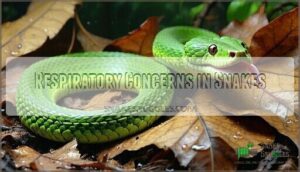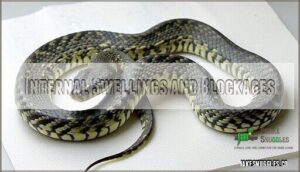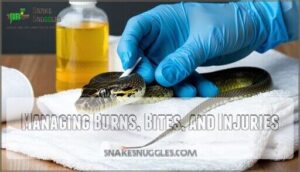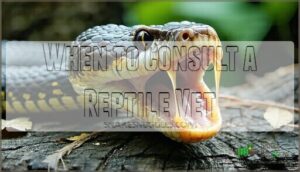This site is supported by our readers. We may earn a commission, at no cost to you, if you purchase through links.

Mouth rot appears as swollen, discolored gums with thick discharge.
Respiratory infections cause wheezing, mouth breathing, and mucus around the nostrils.
Mites look like tiny moving specks on your snake’s skin, while internal parasites trigger weight loss and irregular bowel movements.
Shedding problems leave patches of old skin stuck on your pet.
Most issues stem from improper humidity, temperature, or dirty enclosures.
Quick action prevents minor problems from becoming serious health crises.
Understanding these patterns helps you catch trouble before it spirals out of control, and take quick action to prevent further issues.
Table Of Contents
- Key Takeaways
- Signs of Snake Illnesses
- Diagnosing Digestive Issues in Snakes
- Common Parasites in Snakes
- Respiratory Concerns in Snakes
- Skin Conditions and Shedding Problems
- Treatments for Snake Illnesses
- Internal Swellings and Blockages
- Managing Burns, Bites, and Injuries
- Viral Diseases in Snakes
- When to Consult a Reptile Vet
- Frequently Asked Questions (FAQs)
- What diseases does a pet snake have?
- How do you treat snake diseases?
- What are the signs of illness in snakes?
- How do snake diseases affect my pet reptile?
- Do captive snakes have viral diseases?
- Do snakes have health problems?
- How do you treat a sick snake?
- How to tell if your snake is unwell?
- What kind of sickness do snakes get?
- What are the most common diseases of snakes?
- Conclusion
Key Takeaways
- Watch for early warning signs – You’ll catch problems before they become serious by monitoring for mouth rot (swollen gums, discharge), respiratory issues (wheezing, mouth breathing), and behavioral changes like lethargy or appetite loss.
- Maintain proper environmental conditions – You’ll prevent most illnesses by keeping humidity at 50-60%, providing correct temperature gradients, and cleaning enclosures regularly to eliminate bacteria and parasites.
- Act quickly when symptoms appear – You’ll save your snake‘s life by seeking immediate veterinary care for persistent symptoms, breathing difficulties, or unusual swellings rather than waiting for conditions to worsen.
- Follow proper treatment protocols – You’ll ensure recovery by using veterinarian-prescribed antibiotics for bacterial infections, antiparasitic medications for mites and internal parasites, and making environmental adjustments to support healing.
Signs of Snake Illnesses
Recognizing early signs of illness in your snake can mean the difference between a simple treatment and a serious health crisis.
You’ll want to watch for changes in behavior, appetite, breathing patterns, and physical appearance, as these often signal underlying health problems that need immediate attention.
These signs are crucial because they can indicate serious health issues, and it is essential to address them promptly to prevent further complications.
Mouth Rot Signs
Detecting mouth rot early can save your snake’s life.
This bacterial infection, also known as infectious stomatitis, shows telltale signs you can’t ignore.
Watch for these four key indicators:
- Gums Hemorrhages – Red, bleeding gums signal serious bacterial infection
- Thick Mucus and oral pus around the mouth area
- Sour Smell – A foul odor that’s hard to miss
- Appetite Loss – Your snake refuses food completely
Snake mouth rot requires immediate veterinary attention and proper oral hygiene management.
Symptoms of Constipation
When your snake’s bathroom habits change, constipation might be the culprit.
Watch for reduced defecation patterns lasting over two weeks.
You’ll notice abdominal bloating, making your snake’s midsection appear swollen.
Appetite loss often accompanies this condition, along with lethargy signs like decreased movement.
Dehydration indicators may appear as sunken eyes or sticky mouth.
Poor diet is a common cause of constipation in snakes, which can be found at Poor diet.
These snake symptoms signal digestive snake illnesses requiring prompt snake treatments for effective snake constipation relief.
Indicators of Respiratory Problems
Watch for wheezing sounds and nasal discharge – clear signs your snake’s struggling with respiratory infections.
Open-mouth breathing paired with lethargy signs and abnormal posture indicates serious snake respiratory disease.
These snake respiratory issues affect the snake respiratory system and require immediate veterinary attention, as bacterial pneumonia or fungal infections can quickly worsen without proper treatment.
Anorexia Symptoms
When your snake stops eating, you’re witnessing anorexia – a common snake illness symptom that signals trouble.
When your snake stops eating, you’re witnessing anorexia – a serious red flag demanding immediate attention.
This refusal to feed often accompanies other snake health concerns and requires immediate attention.
- Weight loss becomes noticeable as muscle wasting progresses
- Lethargy signs include reduced movement and extended hiding periods
- Dehydration risk increases without proper nutrition intake
- Snake diseases like respiratory infections often trigger feeding refusal
Monitor these anorexia patterns carefully, as they indicate your snake’s overall well-being and may require snake veterinary care.
Salmonella Indicators
Salmonella poses significant zoonotic risk through fecal shedding from asymptomatic carriers.
You’ll rarely see direct symptoms in snakes, but bacterial infection spreads through poor hygiene protocols.
Snake diseases like this require diagnostic testing to confirm presence.
While your snake appears healthy, it may harbor snake bacterial infection silently.
Always wash hands after handling and maintain strict hygiene protocols to protect snake health and prevent transmission.
| Risk Factor | Description | Prevention |
|---|---|---|
| Fecal Shedding | Bacteria released through droppings | Clean enclosures immediately |
| Cross-contamination | Spread through equipment/surfaces | Disinfect tools between uses |
| Human Contact | Direct transmission via handling | Wash hands thoroughly after contact |
To mitigate these risks, it’s essential to understand the factors involved, including fecal shedding, cross-contamination, and human contact, and to follow the prevention methods outlined.
Signs of Abnormal Swellings
Abnormal swellings in your snake can indicate serious snake diseases requiring immediate attention.
Look for abscess identification signs like firm, localized bumps, hematoma signs including soft, fluid-filled areas, or cyst appearance with smooth, round formations.
Tumor detection involves irregular, hard masses, while edema causes create generalized swelling.
These snake common health issues demand professional snake disease symptoms recognition for proper diagnosis and treatment.
Diagnosing Digestive Issues in Snakes
Digestive problems in snakes can be tricky to spot since these reptiles hide illness well.
You’ll need to watch for specific signs like regurgitation, constipation, or complete food refusal to catch issues early and prevent serious complications, including those related to constipation.
Identifying Vomiting and Regurgitation
Distinguishing vomiting from regurgitation requires careful observation.
Regurgitation happens shortly after eating—you’ll see undigested food. Regurgitation causes include handling stress, temperature fluctuations, or oversized meals.
Vomiting occurs hours later with partially digested contents. Behavioral changes like lethargy and anorexia accompany true illness.
Monitor frequency analysis patterns—repeated episodes warrant veterinary attention.
Recognizing Constipation Causes
Constipation in snakes stems from several interconnected factors affecting gut motility. Dietary imbalance creates digestive slowdowns, while poor hydration levels compound the problem.
Enclosure temperature directly impacts metabolism – too cool means sluggish digestion. Impaction risks increase with inappropriate prey size or substrate ingestion.
Stress, underlying snake diseases, and poor snake husbandry further disrupt normal bowel function. Proper snake health requires monitoring these constipation triggers through consistent snake care practices.
Ideal humidity levels and clean enclosures prevent infections.
Understanding Anorexia in Snakes
When digestive blockages aren’t causing feeding problems, anorexia becomes your next concern. Snake changes in appetite can signal underlying diseases or environmental stress that disrupts normal feeding patterns.
Causes of Anorexia include temperature fluctuations, shedding cycles, and nutritional disorders. Watch for these warning signs:
- Refusing multiple feeding attempts over several weeks
- Weight loss combined with behavioral changes like hiding
- Environmental stressors like improper humidity or lighting
Anorexia Prevention starts with proper snake nutrition and consistent husbandry. Force-Feeding Methods and Nutritional Support should only happen under veterinary guidance to avoid further complications.
Common Parasites in Snakes
Parasites present one of the most persistent health challenges you’ll face as a snake owner, ranging from microscopic internal invaders to visible external pests.
Understanding how to identify and treat these unwelcome guests can prevent serious complications and keep your snake healthy.
Internal Parasites Identification
Identifying snake internal parasites requires microscopic analysis through fecal exams.
These hidden invaders often go undetected until symptoms appear.
Regular parasite detection helps maintain your snake’s health through proper nematode identification and protozoan detection.
- Microscopic worms writhing through digestive samples during laboratory examination
- Tiny egg clusters scattered like pepper flakes across fecal flotation slides
- Protozoan parasites swimming frantically under high-power magnification lenses
- Parasite morphology revealing distinct shapes that identify specific snake parasite treatment needs
External Parasites and Mites
External parasites like mites and ticks create serious health problems for your snake.
These tiny pests follow a mite lifecycle that spreads quickly through your collection.
Watch for small moving dots on your snake’s skin or soaking water.
Anemia risks increase when parasites feed on blood repeatedly.
Implement strict quarantine protocols for new snakes since transmission vectors include contaminated substrate and equipment.
Effective treatment often involves specialized mite products.
Apply topical treatments as directed by your reptile veterinarian to eliminate infestations effectively.
Cryptosporidiosis in Snakes
Moving from external pests to internal ones, cryptosporidiosis presents a more complex challenge. This protozoal parasite targets your snake’s digestive system, causing regurgitation and weight loss that can prove fatal without proper management.
Reptiles can also experience self-reinfection leading to rapid parasite level increases.
Crypto Symptoms:
- Postprandial regurgitation within four days of feeding
- Midbody swelling and visible abdominal distension
- Progressive weight loss despite normal feeding attempts
- Mucoid diarrhea with foul odor in advanced cases.
Crypto Diagnosis proves tricky since infected snakes shed oocysts intermittently.
Crypto Treatment options remain limited, with no consistently effective cure available.
Crypto Prevention focuses on strict quarantine protocols and environmental disinfection.
Crypto Impact on snake health can be devastating, with mortality rates reaching 83% in some populations affected by this persistent snake disease.
Respiratory Concerns in Snakes
You’ll notice respiratory problems in your snake when it breathes with its mouth open, wheezes, or shows thick discharge from its nose or mouth.
These issues can stem from bacterial pneumonia, viral infections like nidovirus, or fungal diseases that thrive in poor environmental conditions.
Bacterial Respiratory Diseases
Bacterial respiratory diseases strike when poor humidity and unsanitary conditions create perfect breeding grounds for harmful bacteria.
Pneumonia causes include environmental stress and vitamin A deficiency. Watch for wheezing, open-mouth breathing, and nasal discharge.
Antibiotic options like enrofloxacin effectively treat bacterial pneumonia. Humidity impact is significant – maintain proper levels as preventative measures against secondary infections.
Viral Respiratory Infections
Someone dealing with viral respiratory infections faces a sneaky enemy that weakens your snake’s defenses. Nidovirus impact and paramyxovirus symptoms create serious breathing troubles through viral transmission and immune suppression.
Ferlavirus, another respiratory virus, can also cause neurologic signs in snakes.
Watch for these warning signs:
- Open-mouth breathing with audible wheezing sounds
- Thick nasal discharge and persistent lethargy
- Complete loss of appetite lasting days
Snake viral infections spread rapidly between animals. Prevention strategies include strict quarantine protocols and immediate veterinary consultation for respiratory infections in snakes.
Fungal Contributions to Respiratory Issues
Fungal respiratory infections pose serious threats to your snake’s health.
These opportunistic pathogens thrive in poorly ventilated, humid environments and often strike immunocompromised animals.
Environmental fungi like Aspergillosis cause severe pneumonia, requiring immediate antifungal therapy.
| Risk Factor | Prevention Strategy |
|---|---|
| High humidity | Maintain 50-60% levels |
| Poor ventilation | Provide adequate airflow |
| Immune suppression | Reduce stress, proper nutrition |
Early detection prevents fatal snake fungal disease complications.
Skin Conditions and Shedding Problems
You’ll notice skin problems in your snake when shedding goes wrong or infections take hold.
Proper humidity and clean conditions prevent most skin issues, but quick treatment saves your snake from serious complications.
Difficulty Shedding (Dysecdysis)
Shedding problems plague snakes when humidity levels drop too low or environmental conditions aren’t right. Dysecdysis occurs when old skin won’t come off properly, creating dangerous complications. You’ll notice retained patches around the eyes, tail tip, or body segments that need immediate attention.
Many keepers find shedding difficulties can be mitigated with proper products.
- Monitor humidity levels – Keep them between 50-60% during shedding cycles
- Provide shedding aids – Add rough surfaces like branches or textured hides
- Check for skin damage – Inspect retained pieces that could restrict blood flow
- Consider nutritional impact – Poor diet weakens shedding ability and recovery
Skin Infections and Dermatitis
Noticed your snake’s scales looking red, swollen, or covered in tiny blisters? These signs of skin infection or ulcerative dermatitis often stem from poor hygiene, bacteria, or dryness.
Help prevent snake scale rot by keeping humidity steady, cleaning regularly, and treating serious cases with antibiotics.
Proper Skin Lesion Care and Dermatitis Treatments keep fungal infections and stubborn dermatitis out of your reptile room.
Managing Mite Infestations
Tackle snake mite infestation by identifying these tiny moving dots on your snake’s skin.
External parasites like mites cause serious irritation and can transmit diseases if left untreated.
Treatment Options:
- Mite Identification – Check for black specks crawling on your snake or floating in water bowls
- Enclosure Cleaning – Deep clean habitat with disinfectant and replace all substrate completely
- Prevention Strategies – Implement quarantine protocols for new snakes and maintain proper humidity levels
Treatments for Snake Illnesses
When your snake falls ill, quick treatment can mean the difference between recovery and serious complications.
You’ll need to understand three main treatment approaches: antibiotics for bacterial infections, medications for parasites, and environmental changes that support healing.
This approach is crucial for the snake’s recovery, and quick action is necessary to prevent serious complications.
Antibiotic Use in Snakes
When treating snake bacterial infections, proper antibiotic selection and dosage calculation are critical for success.
Injectable administration methods prove most effective for systemic infections, while topical applications work for localized wounds.
Monitor for side effects like kidney damage or appetite loss during treatment.
Avoid preventative use to prevent antibiotic resistance—only use snake antibiotics when bacterial infections are confirmed through veterinary diagnosis.
Parasite Medications
Effective antiparasitic medication requires precise dosage calculation based on your snake’s weight and species.
Deworming schedules typically follow veterinary-prescribed intervals to prevent medication resistance. Watch for side effects like lethargy or appetite loss.
You can find snake dewormer products online. Preventative treatments combined with regular fecal exams help control intestinal parasites before they become problematic.
Always consult your reptile veterinarian for proper protocols.
Environmental Adjustments for Health
Beyond medications, proper snake housing creates the foundation for healing and prevents future illness. Your snake’s environment directly impacts its immune system and recovery speed.
- Humidity Control: Maintain species-appropriate levels (50-80%) using water bowls, substrate moisture, or humidifiers to prevent shedding problems and respiratory issues.
- Temperature Gradients: Provide a warm basking spot (85-95°F) and cooler area (75-80°F) so your snake can thermoregulate properly.
- Enclosure Hygiene: Clean substrates weekly and disinfect surfaces monthly to eliminate bacteria and parasites.
- Lighting Needs: Establish consistent day/night cycles for natural stress reduction and proper biological rhythms.
Internal Swellings and Blockages
Internal swellings in your snake can indicate serious blockages, organ enlargement, or fluid buildup that requires immediate attention.
You’ll notice visible lumps, distended body sections, or abnormal bulges along your snake’s length that weren’t there before, which can be a sign of a significant issue, such as blockages.
Causes of Internal Swellings
Internal swellings in your snake can stem from several causes.
Organ enlargement affects the liver or kidneys, while tumor growth creates visible lumps.
Fluid accumulation occurs with infections or heart problems.
Abscess formation develops from bacterial infections, and egg binding happens when females can’t pass eggs normally.
Internal parasites also cause swelling through inflammation and blockages.
Symptoms of Intestinal Blockages
When your snake displays snake illness symptoms, look for specific warning signs of intestinal blockages.
Lethargy and anorexia often accompany digestive obstructions, while regurgitation indicates serious snake health issues.
You’ll notice a palpable mass in the abdomen and signs of dehydration.
These snake disease symptoms require immediate veterinary attention to prevent life-threatening complications from developing.
Diagnostic Procedures for Swellings
When swelling appears in your snake, palpation techniques help identify the location and consistency of masses.
Imaging modalities like X-rays and ultrasounds reveal internal structures, while biopsy analysis and cytology examination determine tissue composition.
Fluid aspiration samples suspicious areas for microscopic evaluation.
These snake disease diagnosis methods guarantee accurate identification before treatment begins.
Managing Burns, Bites, and Injuries
Physical injuries like burns, bites, and trauma require immediate attention to prevent serious complications in your snake.
You’ll need to identify these injuries quickly and provide proper first aid while seeking veterinary care for severe wounds.
Identifying Burns in Snakes
Heat-related injuries require quick identification to prevent serious snake health complications.
Burn severity varies from mild redness to severe blister formation with potential scarring signs.
Monitor these symptoms:
- Red, discolored patches at the burn location where your snake contacted hot surfaces
- Raised blisters or peeling skin that disrupts normal shedding patterns
- Behavioral changes like avoiding basking spots or increased hiding
The healing process takes weeks, and damaged areas risk bacterial infection or fungal infections without proper care.
Treating Bite Wounds
When bite-wounds strike your snake, quick action prevents complications.
Start with gentle wound disinfection using saline solution, then apply bleeding control through direct pressure.
For shallow wounds, topical antibiotic options work well, but deep bites require professional snake antibiotic treatment.
Knowing how to administer snake bite first aid is vital for both humans and animals.
Monitor for snake septicemia signs like lethargy or discoloration.
Proper wound dressings protect healing scales, while pain management and snake supportive care guarantee comfort during scale regeneration.
Preventive Measures for Injuries
Prevention builds stronger defenses than treatment alone. Smart enclosure safety starts with secure latches and smooth surfaces that won’t catch scales. Master gentle handling techniques by supporting your snake’s body weight evenly. Choose proper feeding with pre-killed prey to eliminate bite risks.
- Quarantine protocols: Isolate new snakes for 30-90 days to prevent disease transmission
- Regular checkups: Schedule annual veterinary visits for early disease detection
- Snake husbandry excellence: Maintain ideal temperature, humidity, and cleanliness standards
Viral Diseases in Snakes
Viral diseases represent some of the most serious health threats your snake can face, often causing permanent damage or death.
These infections weaken your snake’s immune system and can spread rapidly through your collection if you’re not careful, leading to permanent damage.
Inclusion Body Disease (IBD)
Your snake’s neurological symptoms like stargazing or loss of coordination could signal snake inclusion body disease (IBD), a fatal reptarenavirus impact.
This devastating condition spreads through IBD transmission via direct contact or contaminated surfaces.
Asymptomatic carriers complicate prevention efforts.
IBD diagnosis requires blood tests detecting inclusion bodies. Unfortunately, no cure exists—only supportive care manages symptoms temporarily before the inevitable decline.
Septicemia Symptoms and Treatment
Septicemia strikes when bacterial infection floods your snake’s bloodstream. You’ll notice red belly scales, severe lethargy, and tongue weakness during handling.
This bloodstream infection often stems from poor husbandry impact like dirty enclosures or untreated wounds. Antibiotic options include injectable medications your vet will prescribe.
Time matters—septicemia treatment requires immediate veterinary care since snake bacterial infections can turn fatal quickly. Clean housing prevents this serious condition.
General Viral Infections
Why do viral infections in snakes remain so challenging to detect? These emerging viruses often trigger weak immune responses, making early detection difficult.
Viral transmission occurs through contaminated equipment or direct contact between infected animals. Prevention strategies include strict quarantine protocols and regular health monitoring.
When snake viral diseases strike, supportive care becomes essential since specific antiviral treatments rarely exist. Most snake infections require immediate veterinary intervention for proper management.
When to Consult a Reptile Vet
You’ll need to contact a reptile vet when your snake shows persistent symptoms like refused meals for weeks, labored breathing, or unusual swellings that don’t resolve quickly.
Don’t wait if you notice severe signs such as mouth rot with thick discharge, neurological symptoms like stargazing, or any combination of lethargy with abnormal behavior patterns, including severe signs.
Persistent Signs of Illness
When your snake shows chronic lethargy, recurring anorexia, unexplained weight loss, or persistent discharge, don’t wait it out.
These snake disease signs indicate serious underlying issues that worsen without treatment.
Behavioral changes like avoiding favorite spots or altered movement patterns signal distress.
Snake physical symptoms persisting beyond a week require professional evaluation, as early intervention prevents complications and improves recovery outcomes substantially.
Unresolved Veterinary Issues
When home treatments aren’t working, it’s time to call in reinforcements.
Sometimes snake health challenges go beyond basic care, requiring professional expertise to solve complex issues.
Consider seeking veterinary consultation for:
- Emerging Diseases – New or unusual symptoms that don’t match typical patterns
- Diagnostic Challenges – When you can’t pinpoint what’s wrong despite obvious illness
- Treatment Resistance – Medications or interventions that aren’t producing expected results
- Ethical Considerations – Quality of life decisions requiring professional guidance.
Professional veterinary care guarantees proper snake disease treatment and prevention strategies for your pet’s wellbeing.
Signs of Severe Illness in Snakes
Beyond unresolved veterinary issues, recognizing severe illness signs becomes life-critical.
When lethargy signs persist with neurological symptoms like stargazing, you’re facing emergency territory. Scale abnormalities, sudden weightloss, and refusal feeding signal severe infections requiring immediate intervention.
These snake diseases don’t wait for convenient timing.
| Warning Signs | Action Required |
|---|---|
| Open-mouth breathing, neurological symptoms | Emergency vet visit |
| Snake behavioral changes, scale rot | Urgent professional care |
| Snake infected signs, seizures | Don’t delay treatment |
Frequently Asked Questions (FAQs)
What diseases does a pet snake have?
Your pet snake can develop respiratory infections, mouth rot, skin problems, parasites, and viral diseases like IBD. Poor husbandry often triggers these conditions, requiring prompt veterinary care.
How do you treat snake diseases?
Like maintaining a car engine, treating snake diseases requires prompt action. You’ll need antibiotics for mouth rot, antifungals for skin infections, and deworming medications for parasites, plus proper husbandry improvements.
What are the signs of illness in snakes?
You’ll notice lethargy, loss of appetite, unusual discharge from mouth or nose, difficulty breathing, abnormal postures like "stargazing," skin discoloration, and changes in normal behavior patterns.
How do snake diseases affect my pet reptile?
Current research suggests snake diseases can seriously compromise your pet’s health through multiple pathways.
Bacterial infections cause mouth rot and skin problems, while respiratory diseases lead to breathing difficulties and lethargy, potentially progressing to fatal septicemia.
Do captive snakes have viral diseases?
Yes, captive snakes can contract several viral diseases.
Inclusion Body Disease affects boas and pythons, causing neurological symptoms like paralysis.
Nidovirus and paramyxovirus also infect captive snakes, weakening their immune systems substantially.
Do snakes have health problems?
Your snake can develop serious health issues ranging from mouth rot and respiratory infections to deadly septicemia and viral diseases that require immediate veterinary attention.
How do you treat a sick snake?
Isolate your snake immediately, then contact a reptile veterinarian for proper diagnosis. Maintain ideal temperature and humidity while providing supportive care like gentle handling and monitoring food intake.
How to tell if your snake is unwell?
An ounce of prevention’s worth a pound of cure, so watch for lethargy, refusing food, wheezing, mouth discharge, unusual posture, skin discoloration, or behavioral changes that signal trouble.
What kind of sickness do snakes get?
Snakes develop bacterial infections like mouth rot, respiratory diseases from poor humidity, parasitic infestations, viral diseases including IBD, skin infections from dirty conditions, and nutritional disorders from improper diets.
What are the most common diseases of snakes?
Like dominoes falling, diseases cascade through your snake’s systems when prevention fails. You’ll encounter mouth rot, respiratory infections, parasites, skin diseases, septicemia, and viral conditions like IBD most commonly.
Conclusion
Picture your snake moving confidently through its habitat, healthy and alert.
Recognizing common snake illnesses and treatments early makes this vision reality. You’ve learned to spot mouth rot, respiratory infections, parasites, and shedding problems before they escalate.
Remember that proper humidity, temperature, and cleanliness prevent most issues.
When you notice persistent symptoms or behavioral changes, don’t hesitate to contact a reptile veterinarian.
Your quick response transforms potential health crises into manageable situations, keeping your serpent companion thriving for years ahead.
- https://www.youtube.com/watch?v=BkxgHcR6AJ4
- https://www.birdexoticsvet.com/post/snake-viral-infections-symptoms
- https://www.reptiles.swelluk.com/help-guides/how-long-can-a-snake-live-with-a-respiratory-tract-infection/
- https://www.safarivet.com/care-topics/reptiles-and-amphibians/boa-and-python/
- https://vethelpdirect.com/vetblog/2021/03/21/what-is-mouth-rot-in-snakes-and-why-does-it-occur/



















